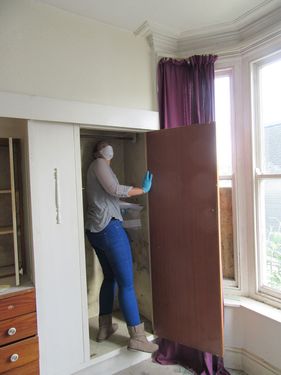Training School 2
printMould Fungi – Evaluation of mould risk. Biocomposites Centre, Bangor, UK. 8-10 June, 2015

In June 2015, the BioComposites Centre at Bangor University North Wales, hosted a 3-day Training school on the evaluation of mould risk in buildings and on materials. The event was held under the auspices of COST action FP 1303 ‘performance of bio-based building materials’. The reasoning behind COST FP1303 is to provide a platform for networking and scientific exchange between different disciplines, such as material sciences, wood technology, biology, biotechnology, building physics and engineering and to coordinate the effort to put the issue of biodegradability of organic building products on the agenda
Performance data for many "environmental friendly" building materials are lacking as well as suitable comprehensive test methodologies to determine their resistance against mould, stain, and decay. The similarity in terms of decay hazard, resulting response on climatic loads and thus performance of different bio-based building materials has not yet been adequately recognised. To that end, 16 participants, (PhD students and early career researchers) from 13 European countries, ranging from Estonia to Bulgaria, were invited to Bangor University to spend three days learning how to assess mould growth both in a laboratory and within a case study building.
To deliver the training, Simon Curling and Graham Ormondroyd from the BioComposites Centre were joined by Mike Hale from the Bangor University School of the Environment, Natural Resources and Geography, Lone Ross Gobakken from the Norwegian institute Skog og Landskap, and Johan Mattsson and Ingeborg Bjorvand Engh from Mycoteam in Norway.
The training school started with an introduction to mould fungi and why they are of interest. This was followed by a trip to a case study building to practice methods of sampling and isolation of moulds from buildings, with an overview of what defects may lead to conditions suitable for moulds. Over the next two days, the students learnt how to culture and identify the moulds that they had sampled from the building. Other topics covered within the training school included the effects of moulds on human health and the current standards available for standardised testing. The training used a very “hands-on” and interactive approach combined with more traditional seminars. The school was also a good opportunity to assess practices, needs and opportunities across Europe. At the end of the school, the participants were left with a better understanding of mould fungi and of the need for testing of both current products and perhaps more importantly future bio-based products.
Presentations available to download:
- Rob Elias – Challenges for bio-based materials in construction
- Simon Curling - Standard methods of assessment of mould growth
- Ingeborg Bjorvand Engh – Modern sampling and analysis techniques
- Lone Ross Gobakken – Building Mycology
- Johan Mattsson - Building physics and building ecology
- Johan Mattsson – Mould and health